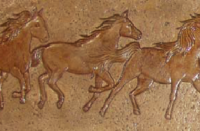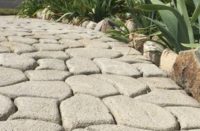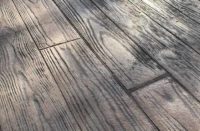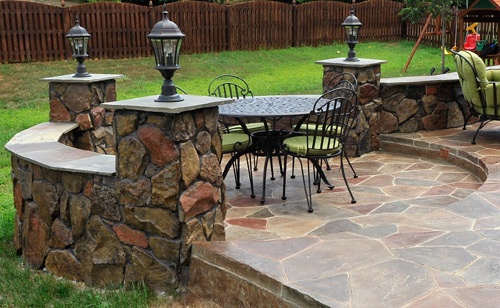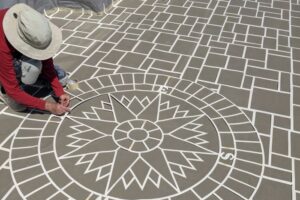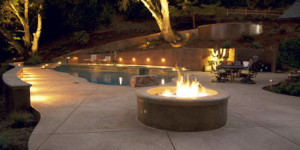The philosophy that “the customer is king” was very much on the mark in the case of the two-tier, stamped and colored concrete patio created by Virginia-based Salzano Custom Concrete for homeowners Christine and Jon Krepsky in Manassas, Va.
The project, which won a first-place prize in the 2013 contest run by the American Society of Concrete Contractors’ Decorative Concrete Council, represented some unique challenges for Salzano Custom Concrete, not least of which was some intensive customer service.
The customer wanted to create a new backyard living space, “but didn’t want a patio area like any others she had seen,” said owner C.J. Salzano in the description of the project submitted as part of the DCC awards review process.
“The main challenge with this project was to understand the unique requirements, i.e., see into the unique vision of this customer and adapt our design and details to satisfy this customer to create their ‘dream backyard,’” Salzano stated in the submission.
Arriving at consensus with the customer on the shape and visuals of that dream backyard involved extensive discussion and sampling of various customized stains, Salzano says.
“We would do a small sample area, and she (Christine Krepsky) would ask it to be a little redder, a little more gold,” Salzano says.
Salzano said he spent two full days on sampling, discussion and eventual coloring of the concrete. The challenge was channeling the client’s vision with an interpretation that delivered a shape, configuration and color combination that reflected a personalized outdoor living space.
This was a classic case of the hands-on customer. But Salzano isn’t complaining. On the contrary, he was ecstatic about the result — and the first-place DCC award in the category of Cast-in-Place, Stamped, Under 5,000 Square Feet. “We ended up with a very unique result,” he says.
The design for the project evolved during a couple of visits to the site and four or five different sketches for a two-tier patio, plus a lower seating area, on the Krepskys’ sloping yard.
Once all were agreed on the plan, work commenced: grading, spreading of the gravel base, installation of steel reinforcement, and pouring of concrete. The Salzano crew poured one of the three sections of the plan at a time, followed by coloring with a hardener — the color Weathered Sage, from Brickform. Then came stamping with Increte Systems’ Large Random Flagstone pattern, and joints in the flagstone pattern were grouted.
So far so good — but when it came to coloring the stone pattern, Salzano and client Christine Krepsky discovered their visions diverged.
“We started out doing three stones with different colors,” Salzano says, using popular earth-type tones of brown, gray and a rusty, bronze color.
Christine, however, had bigger ideas about big color. She pushed the color envelope, and the resulting scheme was a mix of brick red, green, terra cotta, gold and brown.
“These colors are not what you’d find in nature, but the irony was that this project won first place nationwide,” Salzano says. “It didn’t look natural to me, but the judges liked it. My own tendency would be to use colors found when you pull the stone from the ground.”
As for the composition of the color materials, Salzano is somewhat guarded about the specifics, sharing only that they are custom blends of water-based stains mixed by his craftsmen and applied with a combination of brush, rag and sponge. Different colors are applied randomly to individual stone impressions, rendering a sort of speckled look, with a green undertone provided by the color hardener.
A final step was application of a solvent-based, clear acrylic sealer — Super Diamond Clear from Euclid Chemical Co. Salzano’s crew added a nonskid material, Shur-Grip, from Increte Systems.
For the perimeter wall, Salzano Concrete built a conventional CMU structure, then covered that with a veneer of thin-cut stone called Oak Ridge, from Charles Luck Stone Center, of Sterling, Va.
With the wall erected and grout in place, Salzano was surprised when Christine Krepsky expressed approval but asked if the stones could be hand-colored the same way as the patio. “I said, ‘We’ve never done that before,’ but I didn’t see why not,” he says. So the Salzano craftspeople employed the same mix of stains to randomly color the stones. They employed brushes, rags, sponge or a spray bottle, depending on what worked best.
Finally, Christine asked about making the grout lines darker. When advised that would prove somewhat pricey, involving labor-intensive painting by hand, she volunteered to do it herself using a black acrylic stain.
The wall was completed with a cap of flagstones, each approximately 2 feet long and 24 inches wide. An accent color was applied, then the Super Diamond Clear sealer.
Salzano says the project marked a departure from the norm in the degree of customer involvement, but he can’t argue with the results.
“We’ve done over a thousand projects over the last nine years, and this was the most hands-on customer involvement we’ve ever had in terms of putting this color on or that color on, changing it, and so on. It probably added a full day to the project,” he says. “But it was a pleasant, professional relationship, and we worked our way through it and ended up winning a first prize in a national competition.”
Asked his view on why the project struck a resonant chord with the DCC judges, Salzano offers, “It doesn’t look like your run-of-the-mill stamped concrete. And I think they appreciate the extra time, the hands-and-knees effort involved.”
Still, the award came as something of a surprise, he says, in light of the “unusual nature of the colors. My usual interest is to make concrete look like natural stone. Here, the customer led us down a different path, but the result is highly creative and unique, and I think that’s what the judges recognized.”
Project at a Glance
Client: Christine and John Krepsky
Contractor: Salzano Custom Concrete, Centreville, Va.
www.salzanoconcrete.com
Designer: C.J. Salzano
Mix design: Vulcan Materials, Springfield, Va.
www.vulcanmaterials.com
Scope of project: Create a two-level cast-in-place patio with flagstone stone stamp pattern, treated with color hardener and custom stains of various shades
Most challenging aspect: Reaching consensus with the owners on the footprint and visual aspects of the patio, with extensive discussion and customization of stain colors for the stamped elements and a perimeter wall.
Tools and materials used: Increte Systems Large Random Flagstone stamping pattern; Brickform color hardener in Weathered Sage; Euclid Chemical Co. Super Diamond Clear curing and sealing compound; Increte Systems Shur-Grip skid-resistant additive; Charles Luck Stone Center Oak Ridge decorative stone (a blend of weathered face and split-face stone); custom-blended water-based stains
